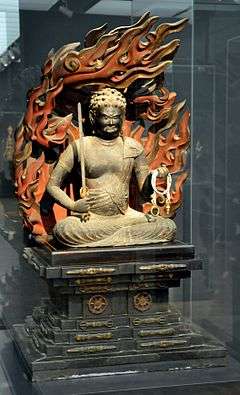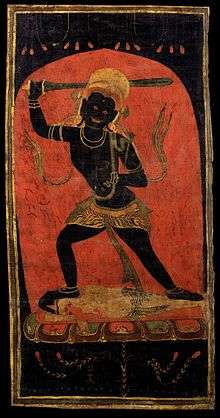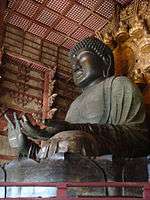Acala
Acala or Achala (Sanskrit: अचल "Immovable") is a dharmapala (protector of the Dharma), prominent in Vajrayana Buddhism and East Asian Buddhism.[1] He is classed among the Wisdom Kings and is preeminent among the Five Wisdom Kings of the Womb Realm. Accordingly, his figure occupies an important hierarchical position in the Mandala of the Two Realms.
| Acala | |
|---|---|
 Statue of Acala, from 12th century Japan. Currently in Rietberg Museum (Zürich, Switzerland) | |
| Sanskrit | अचल (Acala) |
| Chinese | 不动明王; 不動明王; Búdòng Míngwáng |
| Japanese | 不動明王 (Fudō Myōō) |
| Korean | 부동명왕 (Budong Myeongwang) |
| Mongolian | Хөдөлшгүй (Khödölshgüi) |
| Tibetan | མི་གཡོ་བ་ (Miyowa) |
| Vietnamese | Bất Động Minh Vương |
| Information | |
| Venerated by | Vajrayana Buddhism, Mahayana Buddhism, Shugendō |
| Attributes | Vajra |
In China, he is known through esoteric Tangmi traditions as Budong Mingwang ("The Immovable Wisdom King"). In Japan, he is known as Fudō Myōō, which is the on'yomi reading of his Chinese name.[2] Acala is especially important in Japanese Buddhism, where he is venerated in the Shingon, Tendai, Zen, and Nichiren sects, as well as in Shugendō. He is also highly revered among some Yakuza members, who often draw on his intense facial expression and demeanor.
In later Tantric scriptures, the epithet Caṇḍaroṣaṇa and Caṇḍamahāroṣaṇa became more common, and he is known as such in countries like Nepal and Tibet.[3][4][5]
Overview
Descriptions of his physical appearance derive from such scriptural source as the Mahavairocana Tantra and its annotation.[6]
His face is expressive of extreme wrath,[1] wrinkle-browed,[6] left eye squinted[6][7] or looking askance,[6] lower teeth biting down the upper lip. He has the physique of a corpulent (round-bellied) child.[6] He bears a straight sword in his right hand, and a lariat[7] or noose in his left hand. He is engulfed in flame, and seated on a huge rock base.[8]
Acala is said to be a powerful deity who protects the faithful by burning away all impediments (antarāya) and defilements (kleśa), thus aiding them towards enlightenment.[6]
In Japanese esoteric Buddhism, according to an arcane interpretive concept known as the three chakra bodies (三輪身, sanrinjin)[1] Acala and the rest of the five wisdom kings are considered embodiments of the wheel of injunction (教令輪身, kyōryō tenshin),[1] or beings whose actions constitute the teaching of the law (the other embodiments teach by word, or merely by their manifest existence). Under this conceptualization, the wisdom kings are ranked superior to the dharmapala (護法善神, gohō zenshin),[9] a different class of guardian deities. Nevertheless, this distinction sometimes fails to be asserted, or the two are openly treated as synonymous by many commentators, even in clearly Japanese religious contexts.
The Sanskrit-derived symbol that represents Acala is hāṃ हां, conventionally transliterated kān (カーン).[10] However, it has been confounded with the similar glyph (हूं hūṃ), prompting some commentators to mistakenly identify Acala with other deities. This symbol is called a "seed syllable" (bīja), and is written using the Siddham script.
Some of the other transliterations and variants to his name are Ācalanātha, Āryācalanātha, and Ācalavidyārāja. The Nepalese and Tibetan form of this Buddhist deity is also known as Caṇḍamahāroṣaṇa or Caṇḍaroṣaṇa "the violent-wrathful" one.[4]
History

Originally the Mahayana deity Acalanātha,[1] whose name means "immovable protector", Acala was incorporated into Vajrayana Buddhism as a servant of the Buddha.[1] In Tangmi (Tang-era Chinese Vajrayana), his name was translated as Budong "immovable" (Chinese: 不動; pinyin: Búdòng, Middle Chinese: /pǝw dungx/). In turn, the deity was imported into Japan as "Immovable" (不動, Fudō) by the priest Kūkai (died 835)[11] who was studying in China as a member of the Kentoshi mission and founded Shingon Buddhism. Scholars such as Miyeko Murase state that the origins of this Buddhist deity are in the Hindu god Shiva, particularly his attributes of destruction and reincarnation.[12][13]
The deity has been popular throughout the Middle Ages and into modern times in Nepal, Tibet and Japan,[4] where sculptural and pictorial representations of him are most often found. Much of the iconography comes from Japan.[1]
In Tibetan Buddhism and art, the Buddha Akshobhya, whose name also means "the immovable one", presides over the clan of deities to which Ācala belongs.[14] Other sources refer to the Acala and Caṇḍaroṣaṇa as an "emanation" of Akshobhya, suggesting further assimilation.[4]
He evolves into a deity invoked in Buddhist rituals to "frighten gods, titans, men and destroy the strength of demons", and he slays all ghosts and evil spirits.[4] In some Buddhist texts such as the Sādhanamālā, the Hindu gods Vishnu, Shiva, Brahma and Kandarpa (god of love) are said to be "wicked" because they cause endless rebirth, and these gods are terrified of Acala because he carries a rope to bind them. In other texts, such as the Mahāvairocana Sūtra, one dedicated to the Buddha is instructed to visualize the left foot of Acala on his head during meditation, to prevent obstacles in his reaching Prajñā (insight).[4][15]
In the Nepalese and Tibetan Buddhist traditions, Viśvavajrī becomes Acala's consort.[5]
Japan

In Japan, Acala is known as Fudō Myōō (不動明王), which is the on'yomi pronunciation of his Chinese name. He is also known as Fudō for short.
Iconography
Buddhist art since the Heian period has depicted Acala as angry-faced, holding a vajra sword and a lariat.[7] In later representations, such as those used by the yamabushi ascetics, he may have one fang pointing up and another pointing down, and a braid on the one side of his head.[7]
The sword he holds may or may not be flaming and sometimes described only generically as a treasure sword (宝剣, hōken) or as vajra-sword (金剛剣, kongō-ken), which is descriptive of the fact that the pommel of the sword is in the shape of the talon-like vajra (金剛杵, kongō-sho) of one type or another. It may also be referred to as three-pronged vajra sword (三鈷剣, sanko-ken).[16] However, in some cases, as in the Akafudō painting, the divinity is seen holding the Kurikara-ken (倶利伽羅剣),[17] a sword with the dragon coiled around it which nonetheless also has a vajra-shaped pommel.
The flaming nimbus or halo behind the statue is known as the "Garuda flame", after the mythical firebreathing bird from Indian mythology.[6]
The two boy servants who is usually depicted in attendance to Acala are named Kiṃkara (矜羯羅童子, Kongara dōji)[1][6] and Ceṭaka (吒迦童子, Seitaka dōji), though there are said to be eight such boy servants altogether and as many as forty-eight servants overall.[1]
His seat, the huge rock base (盤石座, banjakuza), "is considered an appropriate iconographic symbol to demonstrate the steadfastness of" the Fudō.[8]
Worship
In Japan, Acala became a focus of worship in his own right, and became installed as the main deity at temples and outdoor shrines. A famous example is the Narita Fudō-dō, a Shingon subsect temple at Narita-san.[1]
In Shingon Buddhism, Acala's mantra is directly taken from Sanskrit, and is pronounced in Japanese as "Nōmaku samanda bazaradan sendamakaroshada sohataya hun tarata kan man".
At temples dedicated to Acala, priests perform the Fudō-hō (不動法), or ritual service to enlist the deity's power of purification to benefit the faithful. This rite routinely involves the use of the Homa ritual (護摩, goma)[1] as a purification tool.
Lay persons or monks in yamabushi gear who go into rigorous training outdoors in the mountains often pray to small Acala statues or portable talismans that serve as his honzon.[1] This element of yamabushi training, known as Shugendō, predates the introduction of Acala to Japan. At this time, figures such as the Zaō Gongen (蔵王権現), who appeared before the sect's founder, En no Gyōja, or the Vairocana, were commonly worshiped.[1] Once Acala was added to list of deities typically enshrined by the yamabushi monks, his images were either portable, or installed in hokora (outdoor shrines).[1] These statues would often be placed near waterfalls (a common training ground), deep in the mountains and in caves.[7]
Acala also tops the list of Thirteen Buddhas.[18] Thus Shingon Buddhist mourners assign Fudō to the first seven days of service.[18] The first week is an important observance, but perhaps not as much as the observance of "seven times seven days" (i.e. 49 days) signifying the end of the "intermediate state" (bardo).
Literature on Shingon Buddhist ritual will explain that Sanskrit "seed syllables", mantras and mudras are attendant to each of the Buddhas for each observance period. But the scholarly consensus seems to be that invocation of the "Thirteen Buddhas" had evolved later, around the 14th century[19][20] and became widespread by the following century,[19] so it's doubtful that this practice was part of Kūkai's original teachings.
Conflations and Confusions
There is claim that Acala is identifiable with one of the "two kings" or Niō (仁王), or the gate guardian deities in Japan,[21] but that assertion is not backed by much of the available commentary on the deity. One source which makes this claim explains that the seed syllable हूं hūṃ represents Acala,[21] but Acala's symbol is hāṃ हां as aforementioned, and hūṃ actually belongs to another Wisdom King, Kuṇḍali (軍荼利明王, Gundari Myō-ō).[10]
This latter syllabic symbol, hūṃ (ウン, un), is identified as the "closed mouth" character,[22] frequently associated with the "two kings" or Niō (仁王), whose respective opened or closed mouth features are referred to by the phrase A-un (阿吽). This probably led to the further assertion that Acala was to be identified with the closed-mouthed Niō statue represented by the hūm sound.[21] If Acala were a Niō gate guardian,[23] then by transference he would belong to the class of beings called Vajrapāṇi (執金剛神, Shūkongōshin) (also known as Vajra warriors (金剛力士, Kongōrikishi) in wrestler form), or vajra (lightningbolt) wielding yakṣas (not to be confused with the closely related bodhisattva Vajrapāṇi).[23] Such a case would be contradictory to the aforementioned concept of the "three wheel-embodiments", which considers the wisdom-king a higher class of being than the vajrapāṇi yakṣas and other dharmapala guardian deities.
Nevertheless, that is strictly a Japanese interpretation. It may be noted that one of the Five Wisdom Kings, Vajrayakṣa, bears the same name as this class of deity. In commentary on Tibetan art, one encounters several references to the "Acala-Vajrapāṇi".[4][21]
Gallery
 Modern sculpture at Shinshō-ji temple
Modern sculpture at Shinshō-ji temple
References
- Murakami 1988, Jp. rel. dict., pp.242–246
- Fudō Myōō and Myō-ō, Encyclopædia Britannica
- Weston, David (2018). "The Bayer Collection — University of Glasgow" (PDF). The Bayer Collection.
- Donaldson, Thomas E. (2001). Iconography of the Buddhist Sculpture of Orissa: Text. Indira Gandhi National Centre for the Arts. pp. 219–221. ISBN 978-0-486-25575-0.CS1 maint: ref=harv (link)
- Hugo Kreijger (1999). Kathmandu Valley painting: the Jucker collection. Shambhala. p. 123. ISBN 978-1-57062-454-4.
- Shincho 1985, under Fudo Myoo (in Japanese)
- Snyder 1999 pg. 244
- JAANUS (2001). "iwaza (岩座)". Japanese Architecture and Art Net Users System. Retrieved 9 October 2016.
- ja:護法善神, added 2008.4.23 (Wed) 06:02 by Boca samba (Japanese interwiki link to Dharmapala) makes this distinction.
- Sogeisha. 梵字入門: 仏教美術考古学研究者のための [For the Buddhist art archaeologists: Introduction to Sanskrit]. 綜芸舎編集部. pp. 14–15.
- Murakami 1988, p.243-4, quote "不動信仰を日本にもたらしたのは..空海である"
- Miyeko Murase (1975). Japanese Art. Metropolitan Museum of Art. pp. 31–32. ISBN 978-0-87099-136-3.
- [a] Charles Eliot (1998). Hinduism and Buddhism: An Historical Sketch. Routledge. pp. 391–392. ISBN 978-0-7007-0679-2.;
[b] Charles Eliot (2014). Japanese Buddhism. Routledge. p. 136. ISBN 978-1-317-79274-1. - Weldon, David; Singer, Jane Casey (1999). The sculptural heritage of Tibet: Buddhist art in the Nyingjei Lam Collection. Laurence King Pub.CS1 maint: ref=harv (link), p.100, "Aksobhya, the Buddha who presides over the family (kula) of deities with which Acala is associated"
- Louise Child (2013). Tantric Buddhism and Altered States of Consciousness. Ashgate Publishing. pp. 111–112. ISBN 978-1-4094-7764-8.
- Sato, Ken'ichi(佐藤貫一) (1961). 日本の刀剣 (snippet). Shibundo(至文堂). p. 81.CS1 maint: ref=harv (link)
- Heibonsha (1969) [1968]. 世界百科事典(world encyclopedia).CS1 maint: ref=harv (link), article on "akafudo" by Tanaka, Ichimatsu (田中一松)
- Yamada, Binyō (1894). The Nihon dai jisho. ISBN 978-0-8248-3261-2.CS1 maint: ref=harv (link), Japanese Dictionary, p.748, middle row, under 「志ふさん・ぶつ.. (十三)佛」
- Gerhart, Karen M. (2009). The Material Culture of Death in Medieval Japan (preview). University of Hawaii Press. p. 22. ISBN 978-0-8248-3261-2.CS1 maint: ref=harv (link)
- Kunishige, Masathoshi; illus. Kenji Kagwaguchi(川口健治) (1985). Utsukushiki kokyō Yamaguchi-ken Seibu-ban (美しき故郷山口県西部版) (preview). Fujimoto Printing Corporation. ISBN 978-4-901977-02-9.CS1 maint: ref=harv (link), p.68 gives "late Kamakura Period"
- Getty 1988,p.170, where she gives a walkthrough of the identification of one of the Nio gods as Acala (Fudō)
- Shincho 1985, p.7, article on 阿吽 a-un [a-hūṃ] (in Japanese)
- Shincho 1985, articles on 仁王 Nio p.674, 執金剛神 Shukogoshin p.1084, 金剛力士 Kongorikishi p.565 (in Japanese)
Sources
- Snyder, Gary (1999), "Smokey the Bear Sutra", The Gary Snyder Reader, Counterpoint, p. 241, ISBN 978-1-58243-079-9
- Kenkyusha's New Japanese-English Dictionary, Kenkyusha Limited, Tokyo 1991, ISBN 4-7674-2015-6
- Shincho (1985). 新潮世界美術事典 [Shincho Encyclopedia of World Art]. Shinchosha. ISBN 4-10-730206-7.CS1 maint: ref=harv (link)
- Getty, Alice (1988). The Gods of Northern Buddhism: Their History and Iconography. Courier Dover Publications. p. 170. ISBN 978-0-486-25575-0.CS1 maint: ref=harv (link)
- Murakami, Shigeyoshi(村上重良) (1988). 日本宗教事典 [Japanese religion dictionary]. Kodansha. ISBN 4-06-158837-0.CS1 maint: ref=harv (link)
External links
| Wikimedia Commons has media related to Acala. |
- Fudo Myo-O, 不動明王 O-Fudo-sama in Japan
- Ellen Schattschneider "Fudo Myoo (Acala)" - In: immortal wishes (2003)
- Shingon Buddhist International Institute
- Tendai Buddhist Sangha in Denver Colorado
